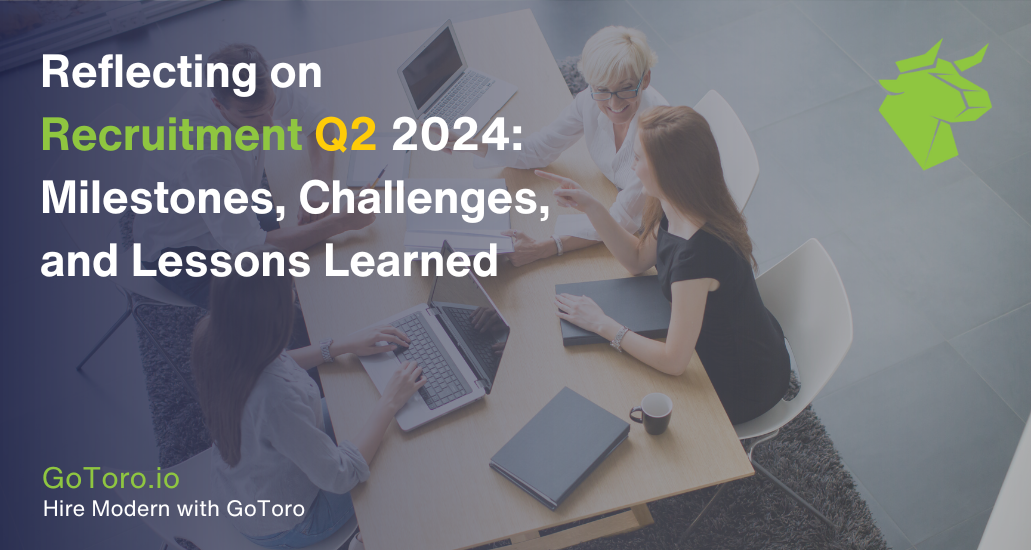Brief Overview of the Recruitment Landscape in Q2 2024

Recruitment Q2 has experienced notable shifts influenced by economic factors, technological advancements, and evolving workforce dynamics. This quarter has seen both significant job growth and increased unemployment, highlighting the complexities within the labor market. Understanding these developments is vital for adapting recruitment strategies and preparing for future trends.
Purpose of Reflecting on This Quarter’s Milestones and Challenges
Reflecting on the milestones and challenges of recruitment in Q2 2024 allows for a deeper understanding of successful strategies and areas needing improvement. This reflection is crucial for recruitment professionals to optimize hiring processes, address economic impacts, and leverage technological advancements effectively.
Summary of the Second Quarter of 2024
Key Insights on Recruitment
In May 2024, the U.S. economy added 272,000 jobs, significantly surpassing economists’ expectations of 185,000 jobs (NBCNews, 2024). This robust job growth underscores the resilience of the job market despite various economic pressures. However, the unemployment rate rose to 4%, the highest level since January 2022, indicating underlying complexities in the labor market (JPMorgan, 2024).
Wage Growth and Labor Force Participation in Recruitment Q2
Wage growth remained strong, with average hourly earnings increasing by 0.4% in May and 4.1% over the past year (CNN, 2024). This indicates ongoing inflationary pressures affecting the economy. Additionally, the labor force participation rate dipped slightly to 62.5%, reflecting a modest decline in workforce engagement. These trends present both opportunities and challenges for recruitment strategies.
Economic Implications for Recruitment
Analysts suggest that the strong job and wage growth might delay potential interest rate cuts by the Federal Reserve due to concerns about inflation. The rise in unemployment, coupled with the concentration of recent job growth in part-time positions, presents a mixed picture of the labor market’s health. These factors highlight the need for strategic adjustments in recruitment Q2 2024 to address both opportunities and challenges in the evolving economic landscape.
Jobs Added by Industry in Recruitment Q2 2024
Healthcare Sector
The healthcare sector added 68,000 jobs in Q2 2024, reflecting the ongoing demand for healthcare professionals (Bureau of Labor Statistics, 2024). This growth is driven by multiple factors, including the continuous impact of health crises and an aging population that requires more medical services. As a result, hospitals, clinics, and other healthcare facilities are expanding their workforce to meet these rising needs, making healthcare a significant contributor to job growth in recruitment Q2 2024.
Government Sector
The government sector saw an addition of 43,000 jobs in Q2 2024, indicating a substantial expansion in public sector employment (Bureau of Labor Statistics, 2024). This growth can be attributed to various federal, state, and local government initiatives aimed at improving public services and infrastructure. Recruitment efforts in the government sector have focused on filling positions across different departments to support these initiatives, contributing to the overall job growth in recruitment Q2 2024.
Leisure and Hospitality Sector
The leisure and hospitality sector increased by 42,000 jobs in Q2 2024, driven by a significant rebound in travel and tourism (Bureau of Labor Statistics, 2024). As pandemic-related restrictions eased, more people began to travel, dine out, and participate in leisure activities. This surge in consumer demand led to a rise in hiring within hotels, restaurants, and entertainment venues, highlighting the sector’s recovery and its role in job creation during recruitment Q2 2024.
Challenges in Recruitment Q2 2024

Employee Expectations in Recruitment Q2 2024
In Q2, one of the prominent challenges has been balancing the diverse expectations of a multigenerational workforce. Many employees now expect hybrid or fully remote work options, a trend accelerated by the COVID-19 pandemic. Younger generations, particularly Millennials and Gen Z, prioritize work-life balance and flexibility, often seeking employers who offer these arrangements. Additionally, there is a growing demand for reskilling and continuous learning opportunities. Employers must invest in training programs and career development initiatives to meet these expectations and retain top talent.
Hiring Processes
Traditional HR processes are increasingly viewed as inefficient in recruitment Q2 2024. Slow hiring processes can give candidates a poor initial impression of a company, leading to lost opportunities in a competitive job market. Streamlining these processes is essential, with many organizations turning to automated systems to speed up tasks like resume screening and initial candidate communications. Despite these efforts, ensuring a smooth and efficient hiring process remains a significant challenge, requiring continuous optimization and adaptation to new technologies.
Local, Regional, and Global Hiring Landscapes
Recruitment Q2 has seen varying hiring landscapes across local, regional, and global markets. There is an expectation of looser labor markets as businesses recover and expand post-pandemic. However, the time to fill roles is increasing due to changing business needs and the struggle of HR departments to keep up with these demands. Employers must navigate these complexities, tailoring their recruitment strategies to different regions and market conditions while addressing global competition for top talent.
Technology in Recruitment
While hiring software is widely used in recruitment Q2, many employers find the return on investment (ROI) insufficient. Challenges include integration with existing systems and effective workforce planning. Technology can streamline various aspects of recruitment, such as applicant tracking, interview scheduling, and onboarding. However, the implementation and maintenance of these systems require significant investment and expertise. Employers need to carefully select and manage their technology stack to ensure it delivers the desired efficiency and effectiveness in their recruitment efforts.
Lessons Learned in Recruitment Q2 2024

Adaptability in Recruitment
One of the key lessons learned in recruitment Q2 is the importance of adaptability. The rapidly changing economic conditions and evolving workforce expectations require organizations to be flexible and responsive. Companies that quickly adapt to new challenges, such as shifting to remote work or modifying hiring processes, are better positioned to attract and retain talent. Adaptability also involves staying current with industry trends and continuously improving recruitment strategies to meet market demands.
Technology Adoption
Leveraging advanced recruitment technologies has proven beneficial in recruitment Q2. Automation tools, artificial intelligence (AI), and data analytics can significantly enhance the efficiency of hiring processes. These technologies help in identifying the best candidates, predicting hiring needs, and streamlining administrative tasks. However, successful adoption requires not only investing in the right tools but also training HR teams to use them effectively. Organizations that embrace technology and integrate it seamlessly into their recruitment strategies gain a competitive edge.
Employee Well-being
Focusing on employee well-being has emerged as a critical aspect of recruitment Q2. With the entry of Gen Z into the workforce, there is a heightened awareness of mental health and work-life balance. Companies that prioritize these aspects create a more attractive work environment for potential employees. This includes offering flexible work arrangements, promoting a healthy work culture, and providing resources for mental health support. Lessons learned emphasize that employee well-being directly impacts recruitment success and retention rates.
Diversity and Inclusion
Progress in creating more inclusive workplaces has been a significant lesson in recruitment Q2 2024. Employers are increasingly recognizing the value of diversity and inclusion (D&I) in fostering innovation and driving business success. This involves implementing fair hiring practices, promoting a diverse workforce, and ensuring an inclusive company culture. D&I initiatives also include training programs to reduce unconscious bias and create equitable opportunities for all employees. Companies that focus on diversity and inclusion not only improve their recruitment outcomes but also enhance their overall organizational performance.
Areas to Focus on in Recruitment Q3 2024
Proactive Candidate Engagement in Recruitment
Proactive candidate engagement will be a critical focus in recruitment Q3. Engaging passive candidates—those who are not actively seeking new opportunities but might be open to the right offer—is essential for filling lower and middle-level roles. This can be achieved through various strategies:
- Personalized outreach tailored to individual candidates’ interests and career goals.
- Building and nurturing online talent communities where potential candidates can engage with the brand.
- Leveraging social media platforms like LinkedIn, Twitter, and industry-specific forums to connect with potential candidates.
- Encouraging employee referrals by incentivizing current employees to refer candidates from their networks. These proactive approaches ensure a robust pipeline of qualified candidates, making recruitment efforts more effective and targeted.
Diversity and Inclusion in Recruitment
Investing in diversity and inclusion (D&I) initiatives is essential for recruitment Q3. Companies must go beyond traditional hiring practices to create a truly inclusive environment. Key strategies include:
- Implementing AI-driven assessment tools that focus on skills and qualifications rather than demographic factors to reduce bias.
- Writing inclusive job descriptions that appeal to a diverse audience and avoid exclusionary language.
- Providing diversity training for hiring managers and HR professionals to recognize and mitigate unconscious bias.
- Collaborating with organizations and educational institutions that support underrepresented groups. By fostering a diverse and inclusive workplace, companies not only enhance their culture but also drive innovation and improve business outcomes.
Data-Centric Recruiting in Recruitment
In recruitment Q3, adopting a data-centric approach will be pivotal for making precise hiring decisions. This involves leveraging advanced technologies and data analytics to inform recruitment strategies. Key actions include:
- Using predictive analytics to identify future hiring needs and trends.
- Tracking key performance indicators (KPIs) such as time-to-hire, cost-per-hire, and quality-of-hire to measure the effectiveness of recruitment efforts.
- Analyzing data to understand the most effective sourcing channels and refine recruitment marketing strategies.
- Applying data-driven insights to improve candidate experience and engagement throughout the recruitment process. By focusing on data-centric recruiting, companies can optimize their hiring processes, making them more efficient and aligned with strategic business goals.
Implementing New Technology in Recruitment Q3 2024
Overview of New Technologies Adopted in Q2 2024
During Q2, several new technologies were adopted to streamline hiring processes and enhance efficiency. These included AI-driven applicant tracking systems that automate resume screening and match candidates to job openings based on their skills and experience. Automated interview scheduling tools reduced administrative burdens, allowing recruiters to focus on strategic tasks. Advanced data analytics platforms provided insights into recruitment performance, helping companies make data-driven decisions.
Impact of AI, Automation, and Other Tech Advancements on Recruitment Processes
AI and automation have significantly transformed recruitment processes in Q2. AI algorithms can quickly analyze vast amounts of candidate data to identify the best matches for open positions. Automation tools streamline repetitive tasks such as scheduling interviews, sending follow-up emails, and onboarding new hires. These advancements have made recruitment processes more efficient, reducing time-to-hire and improving the candidate experience. Additionally, AI-powered chatbots can engage with candidates in real-time, answering their questions and guiding them through the application process.
Future Tech Trends to Watch for in Recruitment Q3 2024 and Beyond
As we move into Q3, focusing on proactive candidate engagement, investing in diversity and inclusion, and adopting data-centric recruiting strategies will be crucial. Embracing new technologies and staying informed about emerging trends will help companies navigate the complexities of the recruitment landscape and achieve their hiring goals.
Reflecting on Q2, we’ve seen significant job growth across various industries due to economic recovery and technological advancements. Challenges included balancing employee expectations, optimizing hiring processes, navigating diverse hiring landscapes, and integrating new technologies. Lessons emphasized adaptability, technology adoption, employee well-being, and fostering diversity and inclusion. Moving into recruitment Q3 2024, focusing on proactive candidate engagement, diversity and inclusion, and data-centric strategies will be crucial. Embrace new technologies and stay informed on trends to navigate the recruitment landscape. Request a demo from GoToro today to streamline your hiring processes and attract top talent.


